Sexual Reproduction in Plants - Pollination | 12th Botany : Chapter 1 : Asexual and Sexual Reproduction in Plants
Chapter: 12th Botany : Chapter 1 : Asexual and Sexual Reproduction in Plants
Pollination
Pollination
Pollination is a wonderful mechanism which provides food, shelter etc., for the pollinating animals.
Many plants are pollinated by a particular
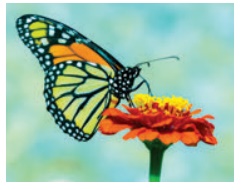
Let us imagine if pollination fails. Do you think there will
be any seed and fruit formation? If not what happens to pollinating organisms
and those that depend on these pollinating organism for the food? Here lies the
significance of the process of pollination.
The pollen grains
produced in the anther will germinate only when they reach the stigma of the
pistil. The reproductive organs, stamens and pistil of the flower are spatially
separated, a mechanism which is essential for pollen grains to reach the stigma
is needed. This process of transfer of pollen grains from the anther to a
stigma of a flower is called pollination.
Pollination is a characteristic
feature of spermatophyte (Gymnosperms and Angiosperms). Pollination in
gymnosperms is said to be direct as the pollens are deposited directly on the
exposed ovules, whereas in angiosperms it is said to be indirect, as the
pollens are deposited on the stigma of the pistil. In majority of angiosperms,
the flower opens and exposes its mature anthers and stigma for pollination.
Such flowers are called chasmogamous and the phenomenon is chasmogamy.
In other plants, pollination occurs without opening and exposing their sex
organs. Such flowers are called cleistogamous and the phenomenon is cleistogamy.
Based upon the flower on
which the pollen of a flower reaches, the pollination is classified into
twokinds,namely,self-pollination(Autogamy) and
cross-pollination(Allogamy).
A.
Self-pollination or Autogamy
(Greek Auto = self,
gamos = marriage):
According to a majority
of Botanists, the transfer of pollen on the stigma of the same flower is called
self-pollination or Autogamy. Self-pollination is possible only in those
plants which bear bisexual flowers. In order to promote self- pollination the
flowers of the plants have several adaptations or mechanisms. They are:
1. Cleistogamy: In cleistogamy (Greek
Kleisto = closed. Gamos = marriage) flowers never open and expose the
reproductive organs and thus the pollination is carried out within the closed
flower. Commelina, Viola, Oxalis are some examples for
cleistogamous flowers. In Commelina benghalensis, two types of
flowers are produced-aerial and underground flowers. The aerial flowers are
brightly coloured, chasmogamous and insect pollinated. The underground flowers
are borne on the subterranean branches of the rhizome that are dull,
cleistogamous and self pollinated and are not depended on pollinators for
pollination.(Figure 1.11).
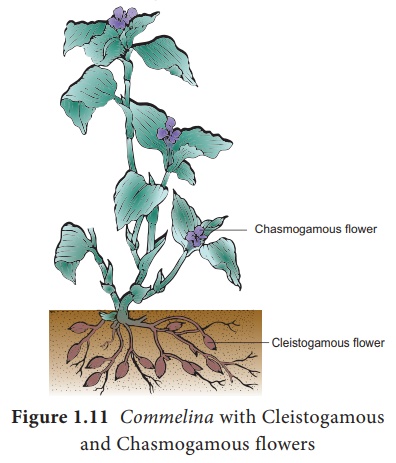
2. Homogamy: When the stamens and stigma
of a flower mature at the same time it is said to be homogamy. It favours self-pollination
to occur. Example: Mirabilis jalapa, Catharanthus roseus
3. Incomplete dichogamy:
In dichogamous flowers
the stamen and stigma of a flower mature at different time. Sometimes , the
time of maturation of these essential organs overlap so that it becomes
favourable for self-pollination.
B. Cross – pollination
It refers to the
transfer of pollens on the stigma of another flower. The cross-pollination is
of two types:
i. Geitonogamy: When the pollen
deposits on another flower of the same individual plant, it is said to
be geitonogamy. It usually occurs in plants which show monoecious condition. It
is functionally cross-pollination but is similar to autogamy because the pollen
comes from same plant.
ii. Xenogamy: When the pollen
(genetically different) deposits on another flower of a different plant
of the same species , it is called as xenogamy.
Contrivances of
cross-pollination
The flowers of the
plants have also several mechanisms that promote cross-pollination which are
also called contrivances of cross-pollination or outbreeding devices. It
includes the following.
1. Dicliny or
Unisexuality
When the flowers are
unisexual only cross-pollination is possible. There are two types.
i. Monoecious:
Male and female flowers on the same plant. Coconut, Bitter gourd. In plants
like castor and maize, autogamy is prevented but geitonogamy takes place.
ii. Dioecious : Male and female
flowers on different plants. Borassus, Carica papaya and
date palm. Here both autogamy and geitonogamy are prevented.
2. Monocliny or
Bisexuality
Flowers are bisexual and
the special adaptation of the flowers prevents self-pollination.
i. Dichogamy: In bisexual flowers
anthers and stigmas mature at different times, thus checking
self-pollination. It is of two types.
a. Protandry: The stamens mature
earlier than the stigmas of the flowers. Examples: Helianthus,
Clerodendrum (Figure 1.12 a).
b. Protogyny: The stigmas mature
earlier than the stamens of the flower. Examples: Scrophularia nodosa
and Aristolochia bracteata (Figure 1.12 b).
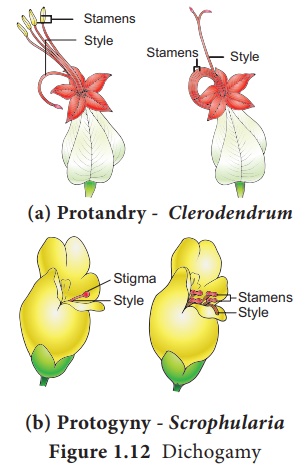
ii. Herkogamy: In bisexual flowers
the essential organs, the stamens and stigmas, are arranged in such a
way that self-pollination becomes impossible. For example in Gloriosa superba,
the style is reflexed away from the stamens and in Hibiscus
the stigmas project far above the stamens (Figure 1.13).
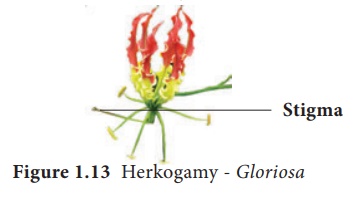
iii. Heterostyly: Some plants produce two
or three different forms of flowers that are different in their length of
stamens and style. Pollination will take place only between organs of the same
length.(Figure 1.14)
a. Distyly: The plant produces two
forms of flowers, Pin or long style, long stigmatic papillae, short
stamens and small pollen grains;
Thrum-eyed or short
style, small stigmatic papillae, long stamens and large pollen grains. Example:
Primula (Figure 1.14a). The stigma of the Thrum-eyed flowers and the
anther of the pin lie in same level to bring out pollination. Similarly the
anther of Thrum-eyed and stigma of pin ones is found in same height. This helps
in effective pollination.

b. Tristyly: The plant produces
three kinds of flowers, with respect to the length of the style and
stamens. Here,the pollen from flowers of one type can pollinate only the other
two types but not their own type. Example : Lythrum (Figure 1.14b).
iv. Self
sterility/ Self- incompatibility: In some
plants, when the pollen grain of a flower reaches the stigma of the same, it is
unable to germinate or prevented to germinate on its own stigma. Examples: Abutilon,
Passiflora. It is a genetic mechanism.
Agents of pollination
Pollination is effected
by many agents like wind, water, insects etc. On the basis of the agents that
bring about pollination, the mode of pollination is divided into abiotic and
biotic. The latter type is used by majority of plants.
Abiotic agents
1. Anemophily -
pollination by Wind
2. Hydrophily -
pollination by Water
Biotic agents
3. Zoophily
Zoophily refers to
pollination through animals and pollination through insects is called
Entomophily.
1. Anemophily:
Pollination by wind. The
wind pollinated flowers are called anemophilous. The wind
pollinated plants are generally situated in wind exposed regions. Anemophily is
a chance event. Therefore, the pollen may not reach the target flower
effectively and are wasted during the transit from one flower to another. The
common examples of wind pollinated flowers are - grasses, sugarcane, bamboo,
coconut, palm, maize etc.,
Anemophilous plants have
the following characteristic features:
·
The flowers are produced in pendulous, catkin-like or spike
inflorescence.
·
The axis of inflorescence elongates so that the flowers are
brought well above the leaves.
·
The perianth is absent or highly reduced.
·
The flowers are small, inconspicuous, colourless, not scented, do
not secrete nectar.
·
The stamens are numerous, filaments are long, exerted and
versatile.
·
Anthers produce enormous quantities of pollen grains compared to
number of ovules available for pollination. They are minute, light and dry so
that they can be carried to long distances by wind.
·
In some plants anthers burst violently and release the pollen into
the air. Example: Urtica.
·
Stigmas are comparatively large, protruding, sometimes branched
and feathery, adapted to catch the pollen grains. Generally single ovule is
present.
·
Plant produces flowers before the new leaves appear, so the pollen
can be carried without hindrance of leaves.
Pollination in Maize (Zea
mays): The maize is monoecious and unisexual. The male
inflorescence (tassel) is borne terminally and female inflorescence (cob)
laterally at lower levels. Maize pollens are large and heavy and cannot be
carried by light breeze. However, the mild wind shakes the male inflorescence
to release the pollen which falls vertically below. The female inflorescence has
long stigma (silk) measuring upto 23 cm in length, which projects beyond
leaves. The pollens drop from the tassel is caught by the stigma (Figure 1.15).
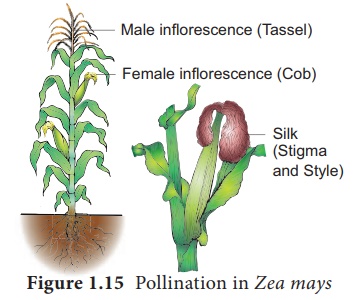
2. Hydrophily:
Pollination by water is
called hydrophily and the flowers pollinated by water are said to be hydrophilous
(Example: Vallisneria, Hydrilla). Though there are a number of
aquatic plants, only in few plants pollination takes place by water. The floral
envelop of hydrophilous plants are reduced or absent. In water plants like Eichhornia
and water lilly pollination takes place through wind or by insects. There are
two types of hydrophily, Epihydrophily and Hypohydrophily. In most of the
hydrophilous flowers, the pollen grains possesses mucilage covering which
protects them from wetting.
a. Epihydrophily: Pollination occurs at
the water level. Examples: Vallisneria spiralis, Elodea.
Pollination in Vallisneria
spiralis: It is a dioecious, submerged and rooted hydrophyte. The
female plant bears solitary flowers which rise to the surface of water level
using a long coiled stalk at the time of pollination. A small cup shaped
depression is formed around the female flower on the surface of the water. The
male plant produces male flowers which get detached and float on the surface of
the water. As soon as a male flower comes in closer to a female flower, it gets
settled in the depression and contacts with the stigma thus bringing out
pollination. Later the stalk of the female flower coils and brings back the
flower from surface to under water where fruits are produced. (Figure 1.16).
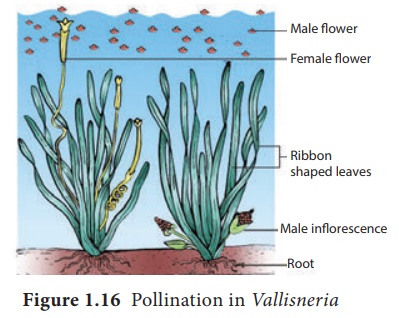
b. Hypohydrophily: Pollination occurs inside
the water. Examples: Zostera marina and Ceratophyllum. Zostera marina
is a submerged marine sea grass and pollination takes place under
water. The pollen grains are long, needle like. They are shed under water. The
specific gravity of the pollen is same as that of sea water, so that, the
pollen floats freely at any depth. The stigma is very large and long. The
pollen comes in contact with the stigma and gets coiled around the stigma thus
effecting pollination.
3. Zoophily:
Pollination by the
agency of animals is called zoophily and flowers are said to be
zoophilous. Animals that bring about pollination may be birds, bats, snails and
insects. Of these, insects are well adapted to bring pollination. Larger
animals like primates (lemurs), arboreal rodents, reptiles (gecko lizard and
garden lizard) have also been reported as pollinators.
A. Ornithophily: Pollination by birds is
called Ornithophily. Some common plants that are pollinated by birds are
Erythrina, Bombax, Syzygium, Bignonia, Sterlitzia etc., Humming
birds, sun birds, and honey eaters are some of the birds which regularly
visit flowers and bring about pollination.
The ornithophilous flowers have the following characteristic features:
·
The flowers are usually large in size.
·
The flowers are tubular, cup shaped or urn-shaped.
·
The flowers are brightly coloured, red, scarlet, pink, orange,
blue and yellow which attracts the birds.
·
The flowers are scentless and produce nectar in large quantities.
Pollen and nectar form the floral rewards for the birds visiting the flowers.
·
The floral parts are tough and leathery to withstand the powerful
impact of the visitors.
B. Cheiropterophily: Pollination carried out
by bats is called cheiropterophily. Some of the common cheiropterophilous
plants are Kigelia africana, Adansonia digitata, etc., Bats are
nocturnal and are attracted by the odour of the flowers that open at or after
dusk. The cheiropterophilous plants have flowers borne singly or in clusters
quite away from the leaves and branches either on the long peduncle or on the
trunk or branches. The flowers produce large quantities of nectar.
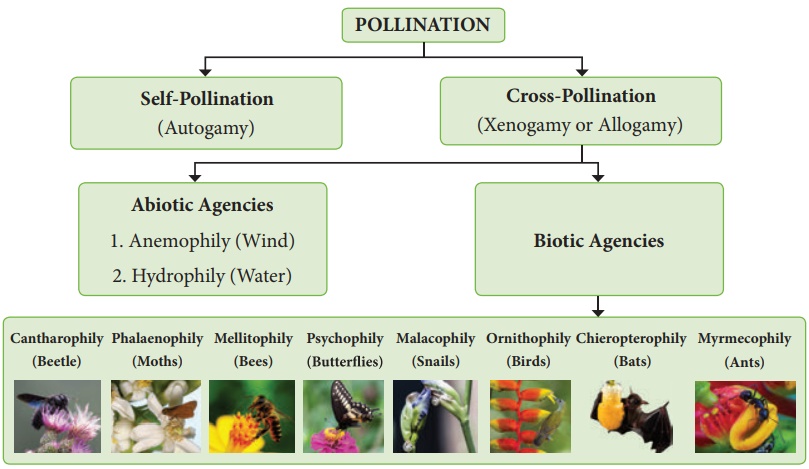
Pollination in Adansonia
digitata: In this plant, the ball of stamens and the stigma project
beyond the floral envelops. The bat holds the flower by clasping the stamen
ball to its breast. While taking nectar its breast becomes laden with numerous
pollen grains, some of which get deposited on the stigma of the flower when it
visits next.
C. Malacophily: Pollination by slugs and
snails is called malacophily. Some plants of Araceae are pollinated by
snails. Water snails crawling among Lemna pollinate them.
D. Entomophily: Pollination by insects
is called Entomophily. Pollination by ant is called myrmecophily.
Insects that are well adapted to bring pollination are bees, moths,
butterflies, flies, wasps and beetles. Of the insects, bees are the main flower
visitors and dominant pollinators. Insects are chief pollinating agents and
majority of angiosperms are adapted for insect pollination. It is the most
common type of pollination.
The characteristic features of entomophilous flowers are as follows:
·
Flowers are generally large or if small they are aggregated in
dense inflorescence.
Example: Asteraceae
flowers.
·
Flowers are brightly coloured. The adjacent parts of the flowers
may also be brightly coloured to attract insect. For example in Poinsettia
and Bougainvillea the bracts become coloured.
·
Flowers are scented and produce nectar.
·
Flowers in which there is no secretion of nectar, the pollen is
either consumed as food or used in building up of its hive by the honeybees.
Pollen and nectar are the floral rewards for the visitors.
·
Flowers pollinated by flies and beetles produce foul odour to
attract pollinators.
·
In some flowers juicy cells are present which are pierced and the
contents are sucked by the insects.
Pollination in Salvia (Lever mechanism):
The flower of Salvia
is adapted for Bee pollination. The flower is protandrous and the corolla is
bilabiate with 2 stamens. A lever mechanism helps in pollination. Each anther
has an upper fertile lobe and lower sterile lobe which is separated by a long
connective which helps the anthers to swing freely. When a bee visits a flower,
it sits on the lower lip which acts as a platform. It enters the flower to suck
the nectar by pushing its head into the corolla. During the entry of the bee
into the flower the body strikes against the sterile end of the connective.
This makes the fertile part of the stamen to descend and strike at the back of
the bee. The pollen gets deposited on the back of the bee. When it visits
another flower, the pollen gets rubbed against the stigma and completes the act
of pollination in Salvia (Figure 1.17a). Some of the other interesting
pollination mechanisms found in plants are a) Trap mechanism (Aristolochia);Pit
fall mechanism (Arum);Clip or translator mechanism (Asclepiadaceae)
and Piston mechanism (Papilionaceae).
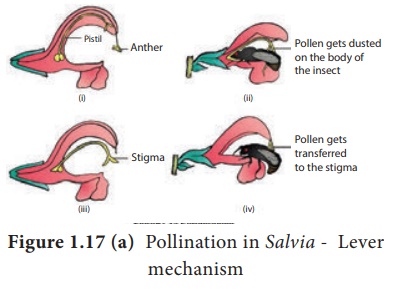
Pollination in Calotropis (Translator mechanism)
This mechanism is found
in members of Asclepiadaceae( Apocynaceae as per APG system of classification).
The flowers are bisexual with 5 stamens forming gynostegium(union of
stigma with the androecium). The stigma is large and 5 – angled and is
receptive on the underside. Each stamen at its back possesses a brightly
coloured hood like outgrowth enclosing horn shaped nectar. The pollen in each
anther lobe of a stamen unites into a mass, forming a pollinium. Pollinia are
attached to a clamp or clip like sticky structure called corpusculum.
The filamentous or thread like part arising from each pollinium is called retinaculum.
The whole structure looks like inverted letter ‘Y’ and is called translator.
When the insect visits the flower for nectar, the translator gets attached to
the proboscis or leg of the visitor. During the visit to the next flower the
pollinia come in contact with the receptive stigma carrying out pollination.
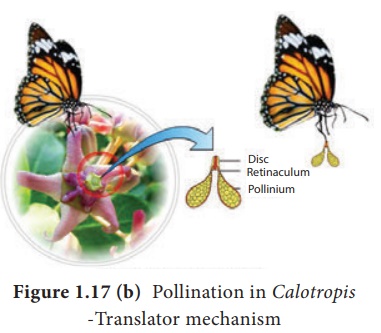
Pollination in Aristolochia (Trap mechanism)
A special mechanism to
accomplish pollination called trap mechanism is found in Aristolochia.
The flowers are axillary and perianth is tubular with a hood at the top. The
basal region is swollen and possesses gynostegium. The gynostegium has six
anthers.
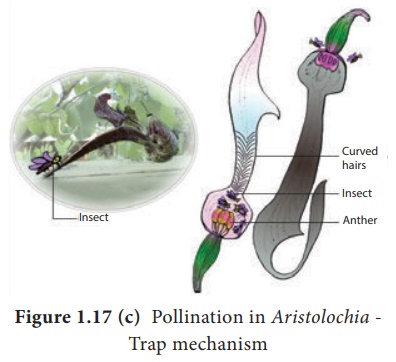
The inner wall of
tubular middle part of the perianth is slippery and lined with stiff hairs
which are pointed downwards. The young flowers are erect. During this stage
small flies enter and could not escape because they are trapped by the hairs.
As soon as the anthers of the flower ripe, the hairs wither and flower bents
down. The flies escape with pollen and enter another flower where it dusts
pollen on the stigma bringing out pollination.
Advantages of self-pollination:
·
Pollination is almost certain in bisexual flowers.
·
When the members of the species are uncommon and are separated by
large distances, the plant has to depend on self-pollination.
·
If all the chances of cross-pollination fails, self-pollination
will take place and prevent the extinction of the species.
Disadvantages of self-pollination:
·
Continuous self-pollination, generation after generation results
in weaker progeny.
·
Chances of producing new species and varieties are meager.
Advantages of cross-pollination:
·
It always results in bringing out much healthier offsprings.
·
Germination capacity is much better.
·
New varieties may be produced.
·
The adaptability of the plants to their environment is better.
Disadvantages of cross-pollination:
·
Depend on external agencies for the pollination and the process is
uncertain.
·
Various devices have to be adopted to attract pollinating agents.
Significance of Pollination
·
Pollination is a pre-requisite for the process of fertilisation.
Fertilisation helps in the formation of fruits and seeds.
·
It brings the male and female gametes closer for the process of
fertilisation.
·
Cross-pollination introduces variations in plants due to the
mixing up of different genes. These variations help the plants to adapt to the
environment and results in speciation.
Related Topics